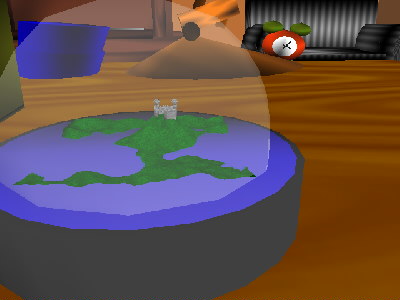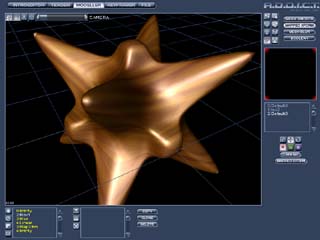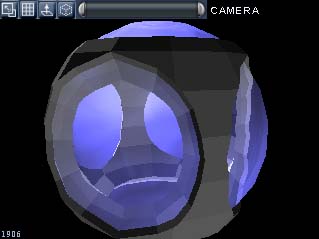Articles
Behind the magic - Generating 3d worlds from scratch
by BoyC / Conspiracy
This is a story of a 64k intro modelling tool and explanation of the ideas behind the file format.
Before anyone reads this please note three things :)
- This is my first article ever ;)
- I've never used a commercial modeller for more than 5 minutes, so I really don't know the standard names for many things I've come up with on my own, so just accept the names I use in this article for now ;)
- I am not a member of Addict the demogroup, it's just a coincidence that my tool is called a.D.D.i.c.t. (advanced Digital Dynamite intro creation tool)
Two years ago I found Ile's article in Hugi#18 about texture generation for 64k intros. I immediately wrote my own "atg loader", and started working on an intro that used it. Still using an old pascal sw render engine, I couldn't handle too many polygons, so it was quite easy to generate the small scenes I could think of from code. A year later my group forced me to learn to use hw acceleration, so I started another intro, now in cooperation with Zoom of Inquisition, who gave me a small spaceship modell, very lowpoly, but with all the filesize optimisation I could think of (I stored normal vectors on 3 bytes etc) it still took 5k from the final exe. The intro came very low at Mekka &emp; Symposium 2002, so on the way back I decided to start some serious coding. This article will be about the experience I gained in almost a year, and some results I came up with. This whole problem looks quite easy from where I am, but what I've seen from the feedback I've got, there is need for a summing article, so I decided to write one :) I hope it'll do for a first article ;)
So the basic concept was, let's say, to go the Farbrausch way :) No copy I think, doing this was mostly a question of patience, realising a quite obvious goal :)

From experience I knew that object generators are good. So the first thing I needed was some generators to work with. Basic geometric shapes come handy like boxes, spheres, etc, I'll get to this later. The second thing was what took most of the time, forgetting modelling from hard code, as it is really a pain in the ass, and creating an interface for these generators. I thought about a script like language and some parser tool for it, but it wouldn't let me see the result. The only acceptable solution was from my opinion a WYSIWYG style interface, as this is easy and fast to use, and it can save directly in the format wich the code uses.
A common 3d modeller and an exporter plugin would have maybe done the job, but at the time I was very far away from coding plugins, and I still coded in pascal (TMT pascal to be exact), so I designed everything from scratch, using what looked to be the smallest solution for file sizes.

Using the basic primitives and storing transformation matrices is the best way I could come up with. 4x4 matrices, that makes 16 floats maximum, 64 bytes + the data for the primitives, let's say 1 byte for the primitive's ID is more than enough, a few, max 2-3 floats/integers for the primitive's basic generation data if it needs any, + material and other minor data for the object, all summing up at ca. 100 bytes for a first count. Uncompressed. Only one thing left, something to generate this data, multiply all the matrices, and do this in a usable way, so I started writing a program that could display a 3d space, use the generators to create primitives, transform them and save the output. Well this is the part that requires patience :) MUCH of it :)
Once the basic primitives and the program to put them around in 3d space were done, it was time to start looking for ways to expand the size efficiency of the format, and start exploring new, easy to generate primitives, wich are also usable in modelling. At the time I had boxes, spheres, tubes, cones and grids, all with adjustable poly number except the box. As the tool only puts down a primitive into a default location and default size, there was soon need of a copy function, that really didn't change nothing in the format, but gave me an idea after using it a while. A new primitive type, I call "Clones". Clones have a fairly easy concept, take the selected objects and merge them down into one single object, wich will be the created primitive, copying all the parent objects, but acting as one single entity from now on. This was the first major breakthru, as a clone only needs to store the ID numbers of the objects wich are located within in addition to the transfromation matrix and the standard object data. Let's say I have a statue made of 30 objects, counting at 100 bytes per object that'll do 3k, but a clone will only take 100 bytes + 31*2 bytes with the list, and it will be an exact copy of the 30 object statue. However, clones in the first version of my tool had a major problem, they didn't follow any movement of the parents after they were created. Anyone trying to write something like this should really use a recursive routine while transformation to see the changes immediately. Believe me, it saves a LOT of work and swearing :) (Rigor, who helped me in the making of my first intro with this tool, had to remodell the Hungarian parliament four times, because clones were still under developement, and he discovered this bug :)

The second, not-too-trivial primitive I use is what I believe is called a "Loft". It uses two tracks to generate a 3d object, one for track, and the other for a mesh. For example if you take two circles, and create a loft from them, you get a torus. Creation is really simple, you just have to go thru the track line, and in every vertex you calculate the orthogonal plane using the current point and the track line's next point as a normal vector, and then project the mesh track on this plane. The polygonal structure of such an object is very easy too, it's identical to that of an x*y grid :) This idea was really a joke for the first time, but it has proved to be very useful in creating complex scenes.
The last thing I had in the first version of the tool was a terrain primitive, wich used a texture from the pool as displacement map. But I still didn't know how much data could be squeezed into a 64k intro, although the filesizes looked very promising. So we started modelling for Flag 2002, and the intro "Testrun" was born (yes, referring to that it is only a test of the file format). It was a 100% success from the test perspective: we had a space scene in two levels of detail, a whole little town, the semantics of the robot from Elitegroup's Kasparov, a sketch of the room from Exceed's Spot: Desktop Adventures with a castle on it wich didn't fit into the music, a Chess table, the hungarian parliament, and even the Flag 2002 partyhall... Still in Pascal, and with Flag starting on the 12th of july, only with 3 months of work. (Exams included ;)

But the pressure to turn to c was big, and as the tool was quite buggy, I decided to fully rewrite it, with a new and advanced gui, and what is more important: more optimized file format and generators.
Optimizing the transformation matrices :) Earlier in the article I calculated 4*4*4 bytes for a transformation matrix. Well it can be done from 36 bytes too with no damage to the modells, and even from 24 with minor changes to the scenes, but these can already be noticed. First of all, only 3*4 rows need to be stored from a 4*4 matrix, as the rest is constantly 0,0,0,1. That leaves us with 48 bytes only, 12 floats. I started experimenting with storing floats on fewer bytes vs accuracy, and the tests indicated that the last byte of a float can be cut without a problem, the last two bytes can be cut too, but the changes will be noticable in the modeller already.
The other way of optimizing my file format was opened with turning to C. Bitfields. I have a 4 byte sequence now in the header of every object, one byte tells the object primitive, the rest tells what data is going to follow, this way the default values don't need to be stored over and over again, thus saving a lot of space. Using these two ways I could reduce the uncompressed filesizes by 40%, using the 36 byte matrix version!
The rewriting of the modeller came with need of some new effects. I threw away the displacement map - terrain primitive, and replaced it with a higher level approach: it could be called a transformation map. I get a value from a texture for every vertex of the object, and then weight any upcoming transformation with this value. This works for moving (displacement map), scaling, and rotation too. Another very easy but very useful idea.


Next special effect was the implementation of the advanced butterfly mesh smooth algorithm, wich ate up a lot of code, and I'm actually thinking about if it was worth it or not, but the results are cool :) For more info on this algorithm check:
http://www.gamasutra.com/features/20000411/sharp_pfv.htm
http://www.gamasutra.com/features/20000425/sharp_pfv.htm
I also did linear mesh smoothing, but only time will tell whether it's used or not.
Third of four special transformations I wrote was an experiment wich turned out kinda cool. Simply "blurring" the mesh like you blur images, using the neighbouring vertices for generating a new position for the actual vertex. Makes everything a bit rounder, may be useful with linear smoothing.

The last special transformation I implemented is still a bit buggy :) But basically it's working: Boolean Operations. Selecting two objects, and cutting them from each other, adding them up, or taking their intersection.
These last transformations are worth an article each on its own so I won't go into detail here, as there are probably better sources than me on these topics :) Especially on Boolean operations.
I am now finishing off the modeller part of the tool with a particle engine, and reorganizing the texturing stuff, and then moving on towards the keyframer, if there is need, I'll sum my experiences again, maybe not in a such story like style :)
Some other pictures can be found at
http://digitaldynamite.demoscene.hu/BoyC
Feel free to contact me with any questions / suggestions / feedback.
See you at Breakpoint 2k3
BoyC of Digital Dynamite
